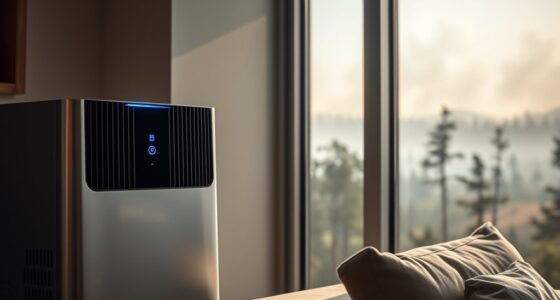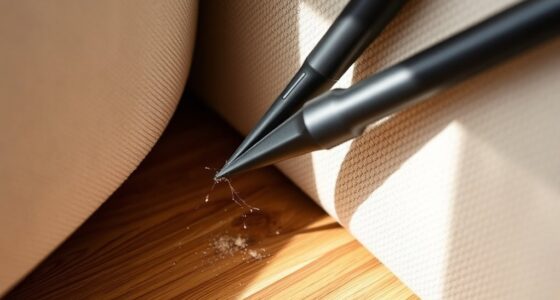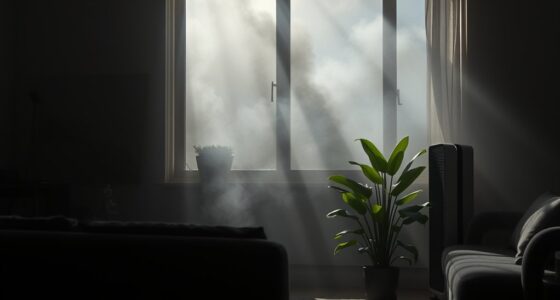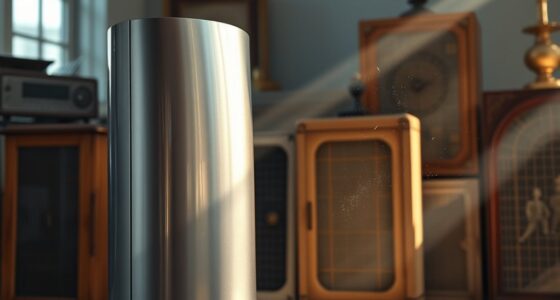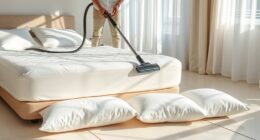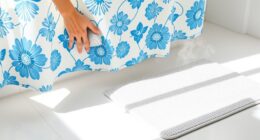If you suffer from seasonal allergies, investing in an air purifier with a HEPA filter can greatly improve your indoor air quality. Before pollen season starts, make sure to check your windows for leaks and enhance your cleaning routine to keep allergens at bay. Regularly maintaining your air purifier is essential, too. Want to learn more about effective strategies for managing allergens at home? There are plenty of tips and tricks to help you prepare.
Key Takeaways
- Invest in a HEPA filter air purifier to effectively capture airborne pollen and reduce indoor allergens during peak allergy seasons.
- Regularly check and seal windows to prevent outdoor pollen from entering your home.
- Implement a cleaning routine using HEPA filter vacuums and damp cloths to minimize dust and allergens indoors.
- Maintain your air purifiers by replacing HEPA filters every 6-12 months and activated carbon filters every 3-6 months.
- Monitor daily pollen levels using apps or websites to prepare for high pollen days and adjust indoor air strategies accordingly.
Understanding Seasonal Allergies
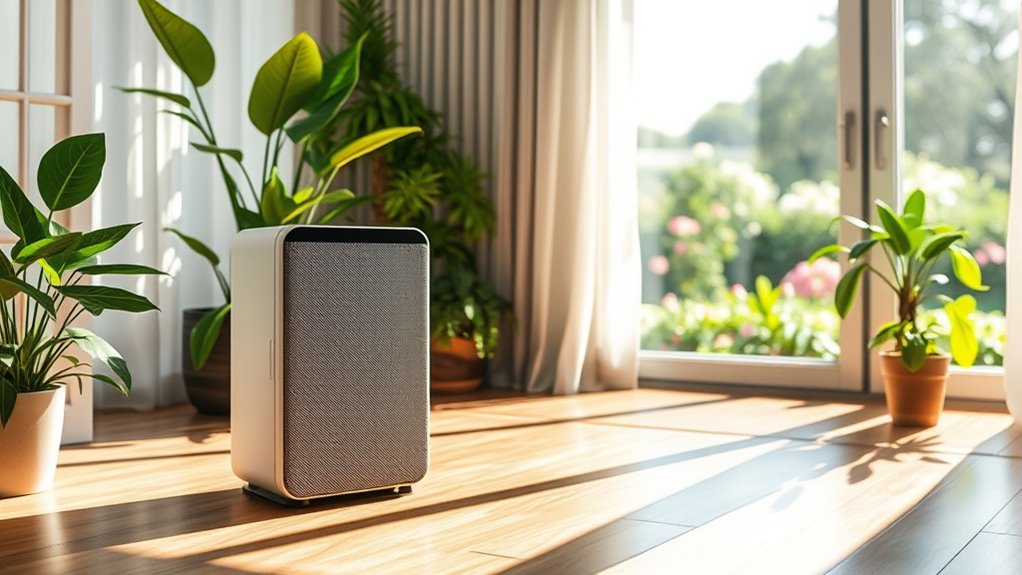
When your immune system overreacts to allergens like pollen, you can experience the frustrating symptoms of seasonal allergies. More than 65 million Americans suffer from these allergy symptoms, especially during spring when pollen levels spike.
Tree pollen peaks from February to April, grass pollen from April to early June, and weed pollen from August until the first hard frost. This variation can make managing your allergies tricky, as different types of pollen affect individuals differently. Utilizing air purifiers with HEPA filtration can help ensure that even the smallest pollen particles are effectively trapped. Furthermore, air purifiers equipped with activated carbon filters can help absorb odors that may accompany seasonal changes, enhancing indoor air quality. Regular maintenance and cleaning of your air purifier is also essential to ensure it operates effectively during these peak allergy times. Additionally, choosing air purifiers with smart technology can provide real-time air quality monitoring, helping you stay informed about your indoor environment.
Awareness of pollen types and their peak seasons is essential for planning your outdoor activities. To help reduce allergens from the air, consider using HEPA filters in your home, as they can trap pollen and improve your indoor air quality, alleviating some of your allergy distress. Additionally, regular use of air purifiers can lead to improved respiratory health, further enhancing your comfort during allergy season.
The Role of Air Purifiers in Allergy Management
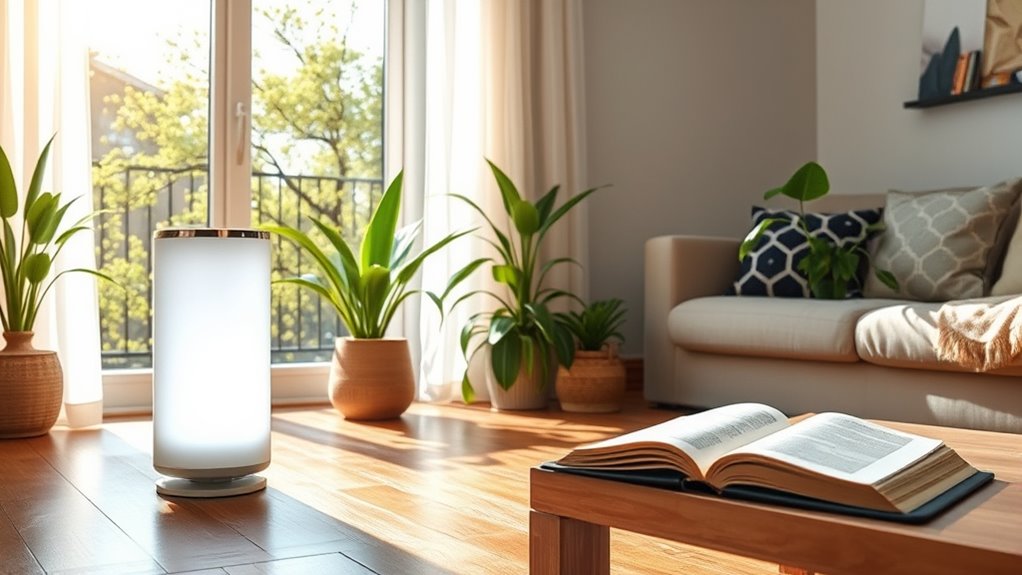
Air purifiers play an essential role in managing seasonal allergies by markedly improving indoor air quality. Equipped with HEPA filters, these devices can capture at least 99.97% of airborne particles, including pollen, which is a major trigger for pollen allergies. Best home security systems demonstrate the importance of reliable performance in preventing issues, similar to how air purifiers function effectively in allergy management.
By continuously purifying the air, you can significantly reduce allergen concentration indoors, offering relief from sneezing and congestion during high pollen seasons. Many air purifiers also feature activated carbon filters to eliminate odors and volatile organic compounds, further enhancing your indoor environment. Additionally, regular filter replacement is crucial for maintaining optimal performance and ensuring that the air purifier continues to effectively remove allergens. Cleaning filters regularly is one of the best ways to support the device’s efficiency. Furthermore, using air purifiers can be especially beneficial during high pollen seasons, when outdoor allergens are at their peak. Studies have shown that HEPA filter technology significantly improves air quality and reduces allergy symptoms for many individuals.
When you combine air purifiers with regular cleaning practices like damp dusting and using HEPA filter vacuums, you not only improve air quality but also create a healthier space for allergy sufferers, leading to better sleep and reduced respiratory issues.
Key Features to Look for in Air Purifiers
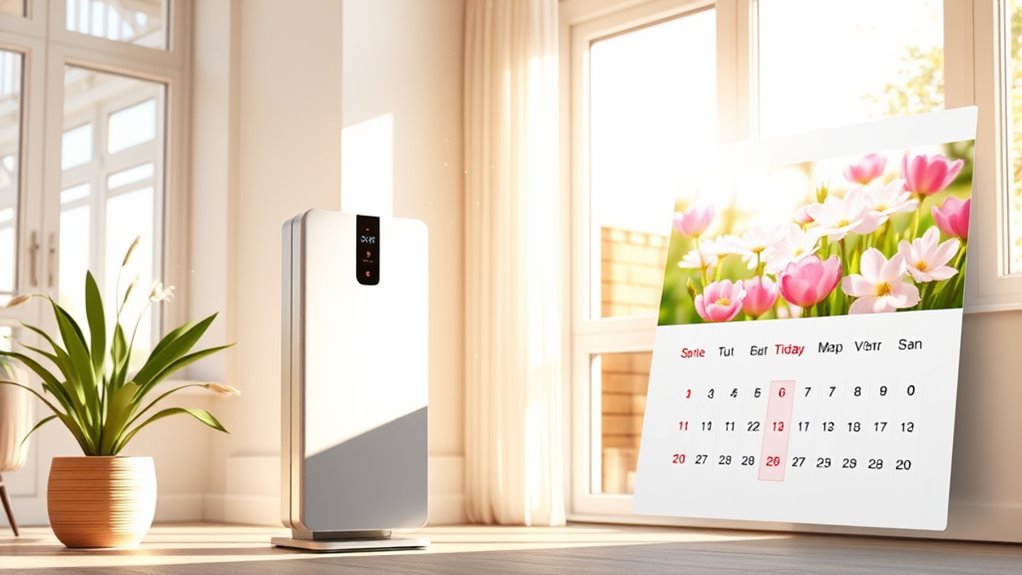
When choosing an air purifier, you’ll want to focus on filter types and their efficiency. HEPA filters are a must for capturing allergens, while activated carbon filters help with odors and gases. Additionally, make sure the purifier is suitable for the size of your room to maximize its effectiveness. Consider how color accuracy in air purifiers can enhance overall air quality by ensuring that pollutants are effectively removed. Furthermore, selecting a purifier with proper sealing mechanisms can improve its efficiency by preventing air leaks. Additionally, look for models that feature energy monitoring capabilities to help manage electricity consumption while effectively improving your indoor air quality. A high-quality air purifier can also help reduce major household energy consumers that may affect your home’s overall energy efficiency. To further enhance your indoor environment, consider incorporating essential oils for aromatherapy to complement the air purification process.
Filter Types and Efficiency
Selecting the right filter type is essential for maximizing the efficiency of your air purifier and alleviating seasonal allergies.
Look for models equipped with HEPA filters, which capture at least 99.97% of particles sized 0.3 microns, effectively removing allergens like pollen and dust from the air. A high Clean Air Delivery Rate (CADR) also matters, as it indicates how much air is filtered over time, ensuring efficient allergen removal.
Don’t overlook activated carbon filters; they eliminate odors, gases, and volatile organic compounds (VOCs), enhancing overall air quality.
Finally, keep maintenance in mind—replace activated carbon filters every 3-6 months to maintain their effectiveness in reducing allergens and improving your indoor environment.
Room Size Compatibility
Choosing the right air purifier for your space is essential, especially if you want to tackle seasonal allergies effectively.
First, check the room size compatibility; effective models will specify their coverage area in square feet. If you have a small room under 300 sq. ft., compact models will suffice, but for larger spaces over 500 sq. ft., opt for those like the LEVOIT Core 600S-P, designed for areas up to 635 sq. ft. Regularly maintaining your purifier by cleaning filters can also help improve its efficiency and enhance its energy efficiency, leading to reduced operational costs. Additionally, vacuums with high suction power are essential for removing allergens from carpets and upholstery. Heat pumps, which can also improve indoor air quality, are often used alongside air purifiers for optimal comfort.
Look for a high Clean Air Delivery Rate (CADR) to guarantee efficient air quality management, particularly during high pollen seasons.
Don’t forget to choose a purifier with a HEPA filter, capable of capturing 99.97% of allergens, guaranteeing your air stays fresh and clean. Additionally, consider smart features such as app control and scheduling to enhance the usability of your air purifier.
Preparing Your Home Before Pollen Season

As pollen season approaches, it’s essential to prepare your home to minimize allergy symptoms effectively.
Start by investing in an air purifier with a HEPA filter, which captures 99.97% of airborne particles, including pollen.
Next, check and repair window seals to keep outdoor allergens from sneaking in, improving your indoor air quality.
It’s also wise to review your family’s allergy management plan with your healthcare provider to guarantee you’re ready for higher pollen counts.
Consider using fans or air conditioning to avoid opening windows on high pollen days.
Finally, regularly clean surfaces with a HEPA filter vacuum and damp cloths to reduce dust and other indoor allergens before the season kicks in. Additionally, incorporating essential oils into your cleaning routine can further enhance indoor air quality.
Maintaining Air Purifiers During Allergy Season
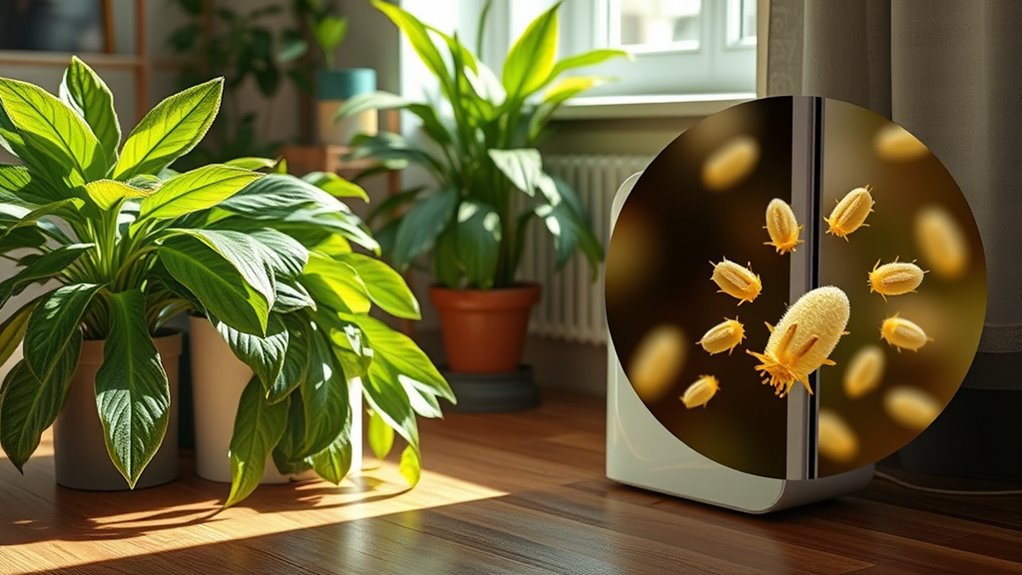
After preparing your home for pollen season, keeping your air purifier in top shape is crucial for managing allergy symptoms effectively.
To maintain ideal indoor air quality, regularly check and replace filters in your air purifiers. HEPA filters should be swapped out every 6-12 months, while activated carbon filters need replacement every 3-6 months. This guarantees they effectively capture pollen and other allergens.
During high pollen days, keep your purifier running continuously, as this maximizes its performance. Position your air purifier centrally and away from walls or furniture to improve airflow.
Monitor the Clean Air Delivery Rate (CADR) to confirm your unit performs well against allergens, providing you with cleaner, healthier air during allergy season.
Monitoring Pollen Levels for Better Management

Keeping an eye on daily pollen levels can greatly enhance your ability to manage allergy symptoms. By monitoring pollen levels, you can plan your outdoor activities to minimize exposure to pollen, especially during peak times for tree, grass, and weed pollen.
Utilizing apps and websites for real-time pollen forecasts helps you stay informed about local air quality, allowing you to adjust your routine and reduce allergy symptoms. Knowing the timing of pollen seasons—from February to April for trees, April to June for grass, and August until frost for weeds—enables better preparation.
With proactive measures, like using air purifiers and medications on high pollen days, you can markedly improve your quality of life during allergy season.
Additional Tips for Reducing Indoor Allergens
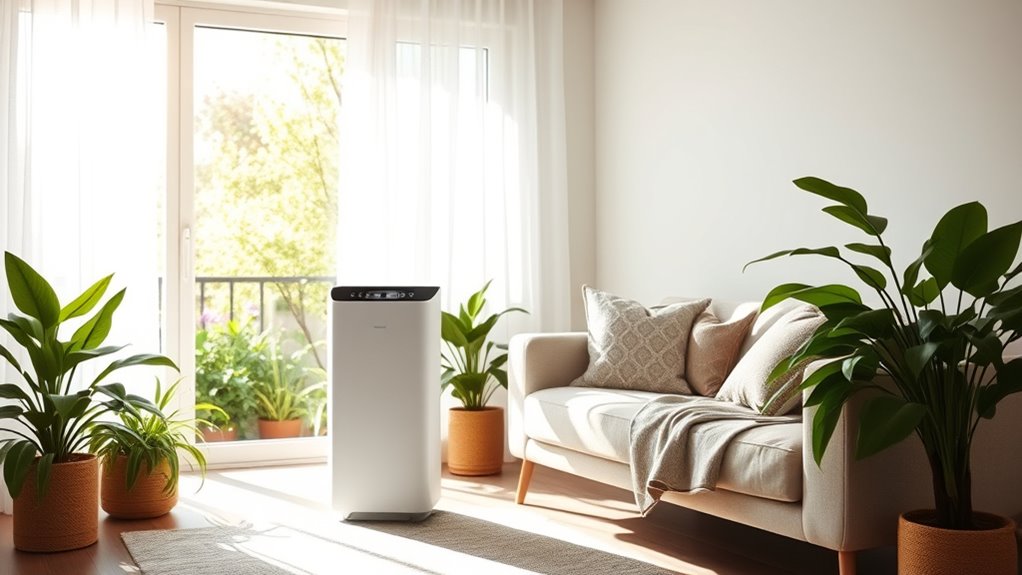
To keep indoor allergens at bay, set up a regular cleaning schedule that targets dust and pet dander.
Make sure to seal your windows properly to prevent outdoor allergens from sneaking in.
Regular Cleaning Schedule
Establishing a regular cleaning schedule is essential if you want to effectively reduce indoor allergens and improve your air quality.
Here are some key steps you can take:
- Vacuum carpets and rugs with a HEPA filter vacuum at least once a week to minimize dust and allergen accumulation.
- Dust surfaces weekly using a damp cloth to capture allergens like pet dander and pollen.
- Wash bedding, including pillowcases and sheets, in hot water (at least 130°F) weekly to eliminate dust mites.
- Maintain a clutter-free environment by minimizing items that collect dust, such as knickknacks and unnecessary textiles.
Additionally, remember to check and replace your air purifier filters every 3-6 months for peak performance against indoor allergens.
Seal Windows Properly
After maintaining a regular cleaning schedule, sealing your windows properly is another effective way to reduce indoor allergens. Properly sealed windows can greatly lower indoor allergen levels during pollen season.
Use weatherstripping or caulk to fill gaps around window frames, blocking drafts and preventing pollen infiltration. Installing window screens with fine mesh helps keep larger pollen particles out while still allowing airflow.
It’s essential to regularly check your window seals for wear and tear; cracked or deteriorating seals can let more allergens in, especially on high pollen days.
Additionally, close your windows during peak pollen times, typically in the morning and early evening, to further enhance your home’s air quality and keep those allergens at bay.
Frequently Asked Questions
Will an Air Purifier Help With Pollen Allergies?
An air purifier can definitely help with pollen allergies. It captures a significant amount of pollen and other airborne particles, improving your indoor air quality.
When choosing one, look for a high Clean Air Delivery Rate (CADR) for better performance.
Just remember, while it reduces allergens, it shouldn’t be your only strategy; keep your windows closed during high pollen counts and maintain the purifier with regular filter changes for ideal results.
How to Prepare for Pollen Allergy?
To prepare for pollen allergies, consult a healthcare provider for a personalized plan and consider allergy testing.
Keep your windows closed during high pollen days and use air conditioning to maintain comfort.
Monitor pollen forecasts to time your outdoor activities for lower levels.
After being outside, wash your hands, change clothes, and shower to remove pollen.
Regular cleaning routines will also help reduce indoor allergens and keep your environment comfortable.
What Is the Best Air Purifier for Pollen Allergies?
When it comes to tackling pollen allergies, you want a trusty ally in your home—an air purifier.
The LEVOIT Core 300S-P stands out for small to medium rooms with its effective HEPA filter, capturing 99.97% of allergens.
If you need something more powerful, consider the LEVOIT Core 600S-P for larger spaces.
Whatever you choose, make certain it has a high CADR rating to keep your air fresh and clean during pollen season.
Is It Worth Getting an Air Purifier for Allergies?
Absolutely, getting an air purifier for allergies can be worth it.
You’ll notice a significant improvement in your indoor air quality, which helps reduce allergy symptoms. A quality air purifier captures allergens like dust, pet dander, and pollen, making your living space healthier.
Plus, it can lessen your reliance on medications by minimizing exposure to irritants. Investing in an effective model can create a more comfortable environment for you and your family.
Conclusion
As pollen piles up, proactive preparations can pave the way for clearer air and calmer days. By choosing the right air purifier and keeping your home tidy, you’ll tackle those troublesome allergens head-on. Don’t forget to monitor pollen counts and maintain your purifier for peak performance. With these smart strategies, you can create a serene sanctuary, ensuring seasonal allergies don’t steal your sunshine. Embrace the fresh air and enjoy a sneeze-free spring!


